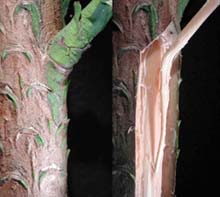The movement of water in the rare Wollemi Pine is “one of a kind”, according to a Charles Sturt University (CSU) botanist.
All trees have systems to carry water from the roots to the leaves, but Dr Geoff Burrows has discovered a “design peculiarity” of the Wollemi which might be part of the reason for the decline of the ancient pine tree, which is now found only in a remote pocket of the Blue Mountains, NSW.
Dr Burrows said he was curious to understand why the Wollemi Pine (Wollemia nobilis) had several highly unusual features.

It is believed to be the only tree species in the world which produces branches which never branch again - “like a ruler with leaves on it” - and which drops whole branches cleanly from the lower trunk with the leaves still attached, rather than dropping individual leaves like other trees. This gives the tree its distinctive ‘umbrella’ shape.
“To have these two unique features in the one tree is remarkable,” Dr Burrows said.
A couple of years ago, Dr Burrows began investigating if these unusual branch features influenced how water is supplied to the leaves. He found there is a remarkable reduction in the number of water conducting cells at the base of each branch.
“It is like connecting a drinking straw to your outside tap, then attaching your normal garden hose to the straw – the straw limits the flow of water from the tap to the hose,” Dr Burrows explained.
The curious water supply structure means branches are only weakly attached to the tree and are very easily shed. This mechanism worked well in the Wollemi’s environment of 60-80 million years ago, when Australia was warm and moist, with high levels of carbon dioxide.
However, as the continent became hotter and drier, the design feature may have created problems for the plant by making it difficult to compete with newer evolving species such as eucalypts which have much stronger water supply structures and are much better adapted to dry conditions.
“This ‘unusual feature’ could be associated with the natural decline of the pine as the continent dried out,” Dr Burrows said. “However it makes the Wollemi Pine an even more interesting species to investigate, conserve and own, now that plants are available to purchase.”
Horticultural experience at Mount Annan Botanic Garden and elsewhere has shown that despite this unusual feature, the Wollemi pine does not require a lot of water to grow well and although not exactly drought tolerant, it requires a lot less water than many species evolved in similar environments.
The Wollemi Pine was discovered in 1994 by a NSW National Parks and Wildlife officer in an isolated gully in the Blue Mountains near Sydney. Only a few of the trees have been found in the gully, although fossil records show the species was once widespread and abundant. Dr Burrows worked with trees produced from seeds supplied by the Mount Annan Botanic Garden near Sydney. His findings will be published in the 99th edition of the prestigious Annals of Botany, published by Oxford University Press.





Social
Explore the world of social